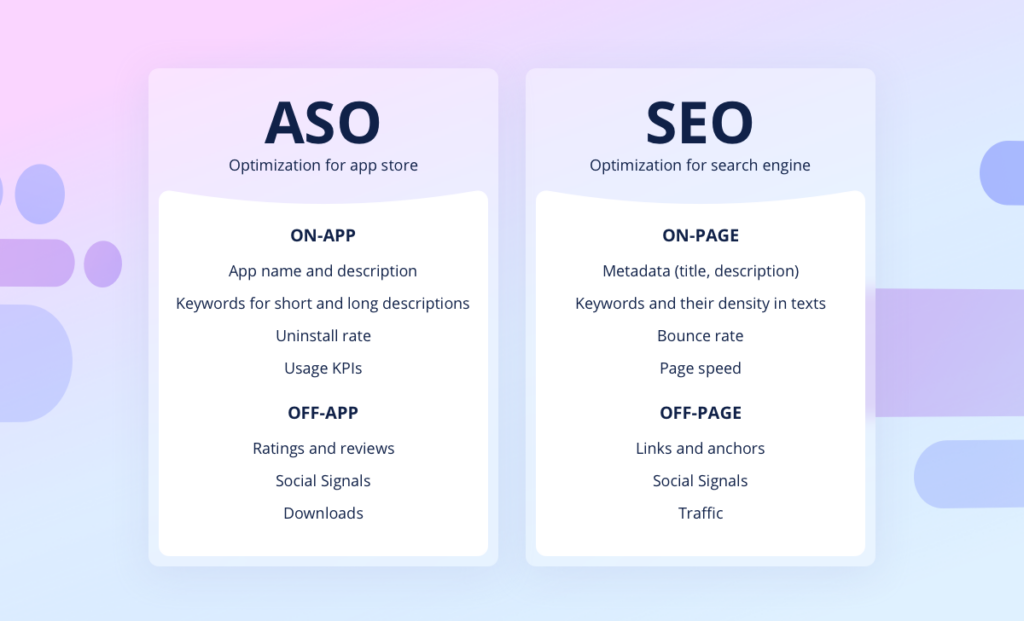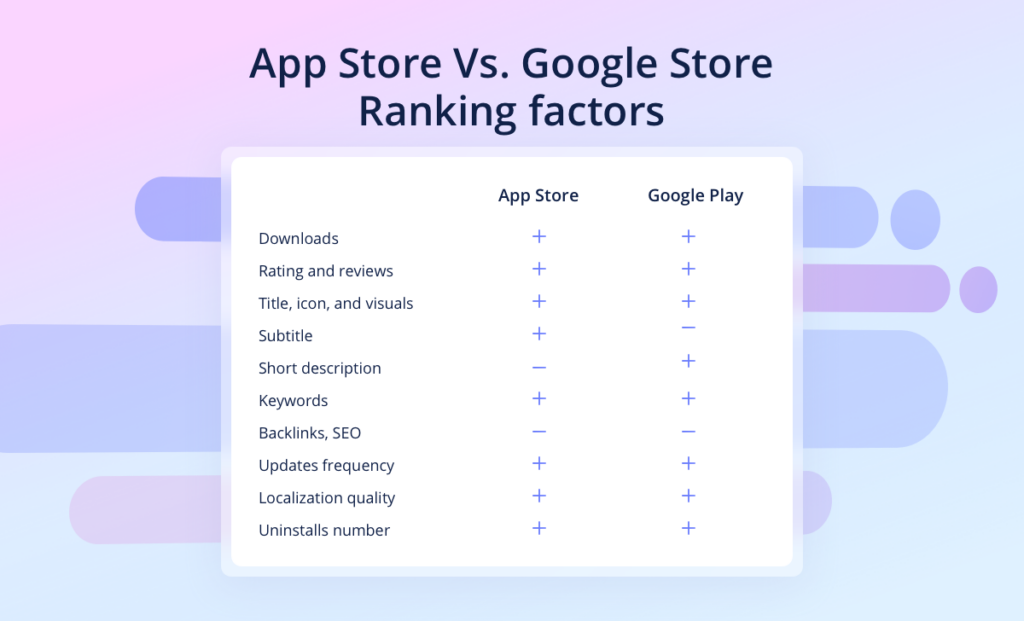In this post, we’ll briefly guide you on how ASO works, let you in on the ultimate advantages of ASO, the main distinctions between mobile and web marketing, the basics of Apple’s vs. Google’s mobile storefront comparison, and the fundamentals of how app marketing works. We’ll share some of the best app store optimization hacks and instruments, as well as provide a complete, straightforward ASO checklist for you to put to practice the knowledge you’ll acquire from this article — and from our other guides. We’ll start with the meaning behind the acronym.
Being productive or finding cheap thrills is a lot easier now that mobile apps have entered our lives. There’s an app for everything these days, and it’s all accessible on the go, right from the palm of your hand. Your app is probably equally easy to pinpoint, but with such a multitude of competitor products, is discovering it truly a cakewalk for your target clients? That’s where ASO (App Store Optimization) kicks in.
App Store Optimization is the process of maximizing your mobile product visibility within the major app distribution platforms, as well as enhancing its conversion parameters. Along with capturing higher positions in the app store search results, ASO also aims at increasing your app’s click-through rate (CTR). It suggests convincing people to tap on your listing when they find it within their preferred mobile app storefront.
Furthermore, a successful ASO strategy is aimed at stimulating users to install your application (read as making a purchase). That particular stage of the whole process is known as app conversion rate. Whether you have already jumped on the app promotion bandwagon or are just planning a mobile app, you’ll find today’s guide and the list of must-dos quite handy.
Table of Contents
ASO vs. SEO: Briefly on How They Differ
Although there are certain common points, they are two standalone notions, of course. Let’s start with the vital similarities within the ASO SEO duet. Both rely on optimization at their core: the former is for web, while the latter is for mobile applications. Both SEO and ASO prioritize keyword exploration and backlink building. The ultimate mission of ASO techniques, as well as SEO strategies, is to improve the visibility/CTR/CRO of a digital product.

In a way, ASO is mobile app SEO. The major distinction between the two ecosystems lies in the ranking parameters and what we’re promoting for. Needless to say that every App Store Optimization tool will differ from that of SEO. As for the list of ranking criteria in terms of mobile marketing, it is shorter as compared to that of the web. We’ll delve into this topic deeper later in this post.
5 Advantages of ASO
Your future clients can find your application in one of the major app stores. Considering the overwhelming competition, simply getting your product on the distribution platform is not enough. You must work on boosting your app store visibility, follow a treasure trove of frequently changing trends, and generally develop a successful optimization strategy while adjusting it to those trends on a regular basis. In other words, ASO marketing is what you want to master if getting your app in front of your target consumers is your utmost priority.
Here’s how exactly ASO aids you in growing your app users organically and continuously:
- Galvanize App Visibility in the App Stores
How can your consumers install and utilize your product if they fail to easily discover it in the first place? ASO is the answer to this crucial question. Irrespective of how brilliant and unique your application is, you need to work on making it easily findable. If you want the time and effort you’re constantly investing in your product to ultimately pay off in a big way, get the marketing going! - Bolster Your App Discoverability
The fact that people can discover your mobile game on their favorite app distribution platform is not enough, alas. The project you’ve worked so hard on completing eating should be easily discoverable within your most relevant target consumers i.e., people who are currently on the prowl for a product exactly like yours. Due to smart keyword enhancement as part of a smart marketing strategy, you can ensure your game is shown in front of the genre enthusiasts it was crafted for. - Maximize Organic Installs
If you work up a really effective marketing plan, you are sure to contribute to elevating your natural app installs to a whole new level and secure a long-term positive outcome for your income. With the right marketing techniques in action, by typing the search terms related to your product into an app store search bar, your potential users will invariably come across your product. Don’t forget that ASO is a dynamic notion, which means you should refine and upgrade your approach on a regular basis. - Save Your Money & Speeding Your Revenue Flow
Wondering how exactly app marketing can save your money? It’s all simple. With a top-level App Store Optimization plan at your fingertips, you won’t have to endlessly splurge on the not-always-effective ads — and get the possibility to focus on purely organic growth while using your time and knowledge as the major investments. This cuts your expenses and ensures rock-steady growth. Furthermore, a smart set of ASO tactics, along with excellent CRO techniques in use, always result in revenue lift. - Reach Clients Globally
By translating your application, as well as your app store pages and all the creatives in other languages (the process is referred to as localization), you will excel in reaching potential customers from across the globe. In other words, ASO adds up to scaling your app on a global level immensely. You can adapt your app for different languages both in App Store and Google Store.
Apple’s vs. Google’s Mobile Storefront
Now that your app is in the final dev stages and you know a thing or two about how to promote it, it’s time to choose where you want it published. You will most likely opt for Apple’s App Store or Android’s Google Play. If your app caters to both operating system aficionados, you can easily aim at getting it published on both stores. Before we switch to the general stuff, let’s discuss the comparison specificities.
One major distinction between the two app distribution platforms lies in the publishing factor. Both stores require an app to go through a specific review procedure for the purpose of enhancing the quality of their catalogs.
Apple will be reviewing your product longer as compared to Google. It means that chances are you’ll achieve the Google Play featuring faster than the Apple Store inclusion. — Asolytics Team
Moving further, keyword polishing is vital for both mobile storefronts. But the ways in which the two platforms evaluate your keywords bear very few similarities. Your ASO for iOS, for instance, must not involve repeating key words throughout your listing. Meanwhile, this technique works wonders as a Google Play optimization tool.
What Influences Your App Store Ranking?
Anyone with a passionate interest in all things ASO iOS related knows how essential your Apple store ranking is. With nearly 65% of people finding apps via rummaging through Apple’s mobile storefront, knowing what exactly influences your ranking is paramount. So, how are apps ranked in the App Store?
Here are five major Store ranking:
- product name, URL, and subtitle;
- what clients say about you online;
- update frequency;
- localization quality;
- installs and user commitment.
Factors That Impact Your Google Play Search Results
Wondering how Google Play’s algorithms work? There are some important parameters that have the greatest influence on your Google storefront ranking. Here’s a brief overview of the major Google Play ranking factors:
- app metadata;
- what clients say about you online;
- backlinks and marketing plan;
- how frequent your updates are;
- the number of uninstalls;
- installs and commitment.

Your App Store Optimization Checklist
The checklist below is all about the steps you need to take when sorting out your mobile marketing. Without further ado, let’s get started with the must-do’s required for a solid ASO strategy. The most important thing is knowing your needs. This, in its turn, will show you where to go next — and revolves around the following vital points:
- knowing where you rank: utilize the Asolytics tools to figure out your position in terms of keywords and visibility;
- creating the list of keywords to target;
- evaluating your efficient competitors based on a multitude of parameters;
- testing an array of potentially effective techniques and plans;
- monitoring the outcome of your marketing activities;
- achieving quality localization.
These six points will lead your optimization efforts along a triumphant path. If you’ve got the required ticks, then you’re more than ready to get your product into the positions it deserves. Always remember that with Asolytics, you will learn all there is to know about each of the aforementioned ranking factors, as well as get to make use of the top-level tools to refine your ASO strategy.
ASO in Action: The Basics
With our comprehensive guides, you become fully equipped with all the right tools for getting out there and pushing your app promotion efforts to the next level. Below, we’ll touch upon the important steps to follow on your way to boosting your mobile expansion.
- Plan Out Your ASO
Know your market inside out. Know your competition even better. Learn to think (and type) like your target audience. Once you’re through with the major analysis of these aspects, take action. Work on finding relevant keywords. Get localization going. Spy on your competition all the time. Keep tabs on ASO dynamics and follow the trends. - Name Your Product Well
Because the name of your product is the first thing that people see, making the right choice here is a must-do. The best app name reflects what your product offers, is concise, a breeze to read, and doesn’t sound like something you’ve heard before. Integrating your most powerful keyword into your app name is sometimes a very good ASO technique. Earlier we wrote about how to name an app. - Write a Solid Description
App description is another vital metadata element. It should embody the heart of your product, as well as contain a summary of its major characteristics. Your app description should be informative, well-structured, and adjusted to suit both your clients and the storefront algorithms. Include bullet points and emojis. Avoid exceeding 4,000 characters in each store. - Decide on the Highest-Performing Icon
Your app icon offers powerful potential for instantly grabbing people’s attention. When working on its design, concentrate on your product’s peculiarities and transform them into the visual form. Less is more is the golden rule here, so make sure your app icon is vibrant without being too overwhelming. A/B test icon to stick with what really works for your consumers. What is ASO test? Read one of our next blog posts for more details on the topic. - Work on Other Creatives
Your app screenshots or preview videos may not be among the direct app store ranking determinants. But they are crucial when it comes to winning over loyal customers the natural way. Therefore, refining these elements is sure to bring you a treasure trove of bonuses.
Furthermore, over 50% of people prefer visuals over text. Which means they may download your app based on the first-sight-oriented opinion only. With that said, make sure the screens and videos you share highlight the best benefits that your product comes with, as well as tell a visual story of its uniqueness. - Keep Track of What Your Clients Say & React Fast
Feedback from your consumers is of the highest importance. And it’s one of the vital aspects of your marketing plan. Both Apple’s and Google’s mobile storefronts consider the comments and reviews your clients leave about your product. The higher your ratings, the better your positions in the search results.
Looking to skyrocket your app reviews and ratings to stardom? Stimulate your users to participate. Do it gently, without pushing too hard. Don’t forget to reply to people’s reviews speedily. That way, you will show your clients that you care and i.e., you can be trusted. Asolytics offers great tools for managing your customer reviews, by the way.
ASO Is an Ongoing Process (That Pays Off Very Well)
App Store Optimization is an ongoing process. Thus, if you’re aiming for some truly brilliant results, be prepared to invest weeks of your time in the operation, along with months of improvement once you overcome the first (and the hardest) milestones of implementing your app promotion plan.
In combination with other marketing channels, ASO is sure to give a significant boost to your product’s findability and growth. Typically, the first results are seen after a month of work, while the number of installs and traffic increase are noticed within up to 3 months. Sounds boring? Maybe. But quick wins no longer equal long-term gains. Yes, ASO is a day to day job that takes time. But the hard work does pay off tremendously.
The silver lining is also that although mobile promotion comes with a certain learning curve, mastering the basics will not be the most challenging task of your life. With some knowledge, in-depth analysis, and determination, you can achieve impressive results, boost your installs on Google Play, increase downloads on the App Store, as well as gain loyal customers and maximize your revenue.
Cutting to the Chase: Don’t Stop ASOing
Last but not least, even if you’re pleased with the results of your ASO campaign, maintaining those achievements is what you should keep laser-like focus on. Therefore, keep working on it all the time. Why? Because the algorithms are constantly shifting, your competitors get fiercely stronger on a daily basis, and your users tomorrow may not be the same as yesterday.
Your product is in the constant process of changing, too, by the way. Growth in this aspect leads to ranking better for high-competition search phrases. And that means your app keyword research is something that will hardly ever end throughout your app promotion journey.
To cut a long story short, make sure that your ASO plan resonates with the ever-changing marketing scene and keeps up with the pace of this constant evolution. That is if you want to keep the precious organic traffic you’ve worked so hard to bring in. We hope our app downloads stats guide helps you reach ASOlute success on your mobile marketing path. You’re very welcome to bookmark our website for more updates.




